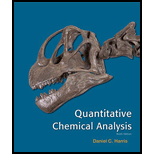
a)
Interpretation:
The absorbance detection limit of the sample has to be calculated.
Concept Introduction:-
Detection limit:-
The concentration of an analyte that produces a signal which is equal to three times the standard deviation of a signal from a blank.
The minimum detectable concentration
Where,
s = Standard deviation.
m = Slope of linear calibration curve.
a)
Answer to Problem 5.AE
The absorbance detection limit of the sample has to be calculated as
Explanation of Solution
Given,
The low concentrations samples near the detection limit are.
Mean reading of nine blanks are
The calculated standard deviation of
The absorbance detection limit of the sample has to be calculated as
b)
Interpretation:
The minimum detectable concentration of the sample has to be calculated.
Concept Introduction:-
Detection limit:-
The concentration of an analyte that produces a signal which is equal to three times the standard deviation of a signal from a blank.
Where,
S = Standard deviation.
m = Slope of linear calibration curve.
b)
Answer to Problem 5.AE
The minimum detectable concentration of the sample has to be calculated as
Explanation of Solution
Given,
The low concentrations samples near the detection limit are.
Mean reading of nine blanks are
The slope of the calibration curve is
The calculated standard deviation of
The minimum detectable concentration of the sample has to be calculated as
c)
Interpretation:
The lower limit quantitation of the sample has to be calculated.
Concept Introduction:-
Detection limit:-
The concentration of an analyte that produces a signal which is equal to three times the standard deviation of a signal from a blank.
Where,
S = Standard deviation.
m = Slope of linear calibration curve.
Lower limit of quantitation:-
In
c)
Answer to Problem 5.AE
The lower limit of quantitation of the sample has to be calculated as
Explanation of Solution
Given,
The low concentrations samples near the detection limit are.
Mean reading of nine blanks are
The slope of the calibration curve is
The calculated standard deviation of
The lower limit of quantitation of the sample has to be calculated as
Want to see more full solutions like this?
Chapter 5 Solutions
Quantitative Chemical Analysis
 ChemistryChemistryISBN:9781305957404Author:Steven S. Zumdahl, Susan A. Zumdahl, Donald J. DeCostePublisher:Cengage Learning
ChemistryChemistryISBN:9781305957404Author:Steven S. Zumdahl, Susan A. Zumdahl, Donald J. DeCostePublisher:Cengage Learning ChemistryChemistryISBN:9781259911156Author:Raymond Chang Dr., Jason Overby ProfessorPublisher:McGraw-Hill Education
ChemistryChemistryISBN:9781259911156Author:Raymond Chang Dr., Jason Overby ProfessorPublisher:McGraw-Hill Education Principles of Instrumental AnalysisChemistryISBN:9781305577213Author:Douglas A. Skoog, F. James Holler, Stanley R. CrouchPublisher:Cengage Learning
Principles of Instrumental AnalysisChemistryISBN:9781305577213Author:Douglas A. Skoog, F. James Holler, Stanley R. CrouchPublisher:Cengage Learning Organic ChemistryChemistryISBN:9780078021558Author:Janice Gorzynski Smith Dr.Publisher:McGraw-Hill Education
Organic ChemistryChemistryISBN:9780078021558Author:Janice Gorzynski Smith Dr.Publisher:McGraw-Hill Education Chemistry: Principles and ReactionsChemistryISBN:9781305079373Author:William L. Masterton, Cecile N. HurleyPublisher:Cengage Learning
Chemistry: Principles and ReactionsChemistryISBN:9781305079373Author:William L. Masterton, Cecile N. HurleyPublisher:Cengage Learning Elementary Principles of Chemical Processes, Bind...ChemistryISBN:9781118431221Author:Richard M. Felder, Ronald W. Rousseau, Lisa G. BullardPublisher:WILEY
Elementary Principles of Chemical Processes, Bind...ChemistryISBN:9781118431221Author:Richard M. Felder, Ronald W. Rousseau, Lisa G. BullardPublisher:WILEY





